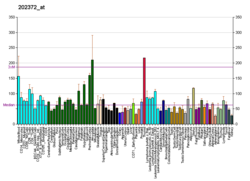RAB3GAP2
Protein-coding gene in the species Homo sapiens
| RAB3GAP2 | |||||||||||||||||||||||||||||||||||||||||||||||||||
|---|---|---|---|---|---|---|---|---|---|---|---|---|---|---|---|---|---|---|---|---|---|---|---|---|---|---|---|---|---|---|---|---|---|---|---|---|---|---|---|---|---|---|---|---|---|---|---|---|---|---|---|
| Identifiers | |||||||||||||||||||||||||||||||||||||||||||||||||||
| Aliases | RAB3GAP2, RAB3-GAP150, RAB3GAP150, SPG69, WARBM2, p150, RAB3 GTPase activating non-catalytic protein subunit 2, MARTS1 | ||||||||||||||||||||||||||||||||||||||||||||||||||
| External IDs | OMIM: 609275; MGI: 1916043; HomoloGene: 40842; GeneCards: RAB3GAP2; OMA:RAB3GAP2 - orthologs | ||||||||||||||||||||||||||||||||||||||||||||||||||
| |||||||||||||||||||||||||||||||||||||||||||||||||||
| |||||||||||||||||||||||||||||||||||||||||||||||||||
| |||||||||||||||||||||||||||||||||||||||||||||||||||
| |||||||||||||||||||||||||||||||||||||||||||||||||||
| |||||||||||||||||||||||||||||||||||||||||||||||||||
| Wikidata | |||||||||||||||||||||||||||||||||||||||||||||||||||
| |||||||||||||||||||||||||||||||||||||||||||||||||||
Rab3 GTPase-activating protein non-catalytic subunit is an enzyme that in humans is encoded by the RAB3GAP2 gene.[5][6][7]
Members of the RAB3 protein family (see RAB3A; MIM 179490) are implicated in Ca(2+)-dependent exocytosis. RAB3GAP, which is involved in regulation of RAB3 activity, is a heterodimeric complex consisting a 130-kD catalytic subunit (RAB3GAP1; MIM 602536) and a 150-kD noncatalytic subunit (RAB3GAP2) (Nagano et al., 1998).[supplied by OMIM][7]
References
- ^ a b c GRCh38: Ensembl release 89: ENSG00000118873 – Ensembl, May 2017
- ^ a b c GRCm38: Ensembl release 89: ENSMUSG00000039318 – Ensembl, May 2017
- ^ "Human PubMed Reference:". National Center for Biotechnology Information, U.S. National Library of Medicine.
- ^ "Mouse PubMed Reference:". National Center for Biotechnology Information, U.S. National Library of Medicine.
- ^ Nagase T, Ishikawa K, Suyama M, Kikuno R, Hirosawa M, Miyajima N, Tanaka A, Kotani H, Nomura N, Ohara O (May 1999). "Prediction of the coding sequences of unidentified human genes. XII. The complete sequences of 100 new cDNA clones from brain which code for large proteins in vitro". DNA Res. 5 (6): 355–64. doi:10.1093/dnares/5.6.355. PMID 10048485.
- ^ Aligianis IA, Johnson CA, Gissen P, Chen D, Hampshire D, Hoffmann K, Maina EN, Morgan NV, Tee L, Morton J, Ainsworth JR, Horn D, Rosser E, Cole TR, Stolte-Dijkstra I, Fieggen K, Clayton-Smith J, Megarbane A, Shield JP, Newbury-Ecob R, Dobyns WB, Graham JM Jr, Kjaer KW, Warburg M, Bond J, Trembath RC, Harris LW, Takai Y, Mundlos S, Tannahill D, Woods CG, Maher ER (Mar 2005). "Mutations of the catalytic subunit of RAB3GAP cause Warburg Micro syndrome". Nat Genet. 37 (3): 221–3. doi:10.1038/ng1517. PMID 15696165. S2CID 7561087.
- ^ a b "Entrez Gene: RAB3GAP2 RAB3 GTPase activating protein subunit 2 (non-catalytic)".
Further reading
- Nagano F, Sasaki T, Fukui K, et al. (1998). "Molecular cloning and characterization of the noncatalytic subunit of the Rab3 subfamily-specific GTPase-activating protein". J. Biol. Chem. 273 (38): 24781–5. doi:10.1074/jbc.273.38.24781. PMID 9733780.
- Nakajima D, Okazaki N, Yamakawa H, et al. (2003). "Construction of expression-ready cDNA clones for KIAA genes: manual curation of 330 KIAA cDNA clones". DNA Res. 9 (3): 99–106. doi:10.1093/dnares/9.3.99. PMID 12168954.
- Strausberg RL, Feingold EA, Grouse LH, et al. (2003). "Generation and initial analysis of more than 15,000 full-length human and mouse cDNA sequences". Proc. Natl. Acad. Sci. U.S.A. 99 (26): 16899–903. Bibcode:2002PNAS...9916899M. doi:10.1073/pnas.242603899. PMC 139241. PMID 12477932.
- Ota T, Suzuki Y, Nishikawa T, et al. (2004). "Complete sequencing and characterization of 21,243 full-length human cDNAs". Nat. Genet. 36 (1): 40–5. doi:10.1038/ng1285. PMID 14702039.
- Lehner B, Sanderson CM (2004). "A Protein Interaction Framework for Human mRNA Degradation". Genome Res. 14 (7): 1315–23. doi:10.1101/gr.2122004. PMC 442147. PMID 15231747.
- Aligianis IA, Morgan NV, Mione M, et al. (2006). "Mutation in Rab3 GTPase-Activating Protein (RAB3GAP) Noncatalytic Subunit in a Kindred with Martsolf Syndrome". Am. J. Hum. Genet. 78 (4): 702–7. doi:10.1086/502681. PMC 1424696. PMID 16532399.
- Gregory SG, Barlow KF, McLay KE, et al. (2006). "The DNA sequence and biological annotation of human chromosome 1". Nature. 441 (7091): 315–21. Bibcode:2006Natur.441..315G. doi:10.1038/nature04727. PMID 16710414.
- Ewing RM, Chu P, Elisma F, et al. (2007). "Large-scale mapping of human protein–protein interactions by mass spectrometry". Mol. Syst. Biol. 3 (1): 89. doi:10.1038/msb4100134. PMC 1847948. PMID 17353931.
- v
- t
- e



















